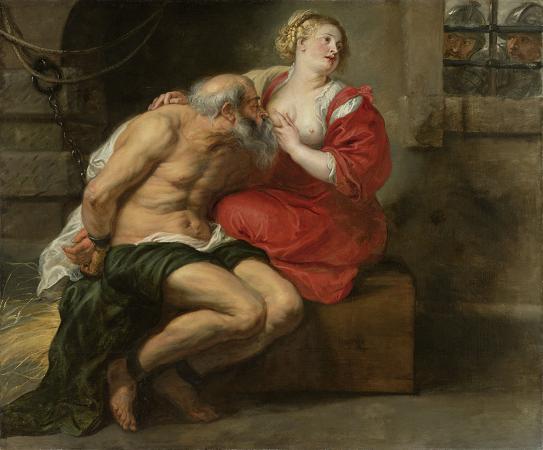
Roman Charity. Roman Charity is the exemplary story of a woman, Pero, who secretly breastfeeds her father, Cimon, after he is incarcerated and sentenced to death by starvation.
The story is recorded in Factorum ac dictorum memorabilium by the ancient Roman historian Valerius Maximus, and was presented as a great act of pietas and Roman honour. A painting in the Temple of Pietas depicted the scene.
Among Romans, the theme had mythological echoes in Juno's breastfeeding of the adult Hercules, an Etruscan myth. The story of Cimon is predated, however, by an almost identical story recorded by Roman historian Valerius Maximus, later retold by Pliny the Elder, of a jailed plebeian woman who was nursed by her daughter.
Historians note that Renaissance and Baroque depictions have more incestuous overtones. In the seventeenth and eighteenth centuries, many European artists depicted the scene.
Peter Paul Rubens is known to have painted several versions. Baroque artist Caravaggio also featured the scene in his work from 1606, The Seven Works of Mercy. Neoclassical depictions tended to be more subdued. The original legend does not mention Pero's child. This element was introduced in the 17th century in order to prevent an interpretation that there was something incestuous about the deed. At the same time, the inclusion of the infant added a new level of meaning to the story as the three figures would rep
The story is recorded in Factorum ac dictorum memorabilium by the ancient Roman historian Valerius Maximus, and was presented as a great act of pietas and Roman honour. A painting in the Temple of Pietas depicted the scene.
Among Romans, the theme had mythological echoes in Juno's breastfeeding of the adult Hercules, an Etruscan myth. The story of Cimon is predated, however, by an almost identical story recorded by Roman historian Valerius Maximus, later retold by Pliny the Elder, of a jailed plebeian woman who was nursed by her daughter.
Historians note that Renaissance and Baroque depictions have more incestuous overtones. In the seventeenth and eighteenth centuries, many European artists depicted the scene.
Peter Paul Rubens is known to have painted several versions. Baroque artist Caravaggio also featured the scene in his work from 1606, The Seven Works of Mercy. Neoclassical depictions tended to be more subdued. The original legend does not mention Pero's child. This element was introduced in the 17th century in order to prevent an interpretation that there was something incestuous about the deed. At the same time, the inclusion of the infant added a new level of meaning to the story as the three figures would rep
Wikipedia ...